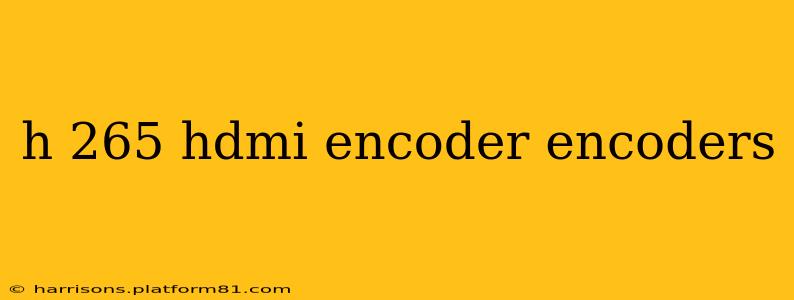The world of video encoding is constantly evolving, and H.265 (also known as HEVC, High-Efficiency Video Coding) has become a leading standard for its superior compression efficiency. This guide explores H.265 HDMI encoders, their benefits, applications, and factors to consider when choosing one. We'll delve into frequently asked questions to ensure you have a complete understanding of this vital technology.
What is an H.265 HDMI Encoder?
An H.265 HDMI encoder is a device that takes an HDMI video signal as input and converts it into a compressed H.265 video stream. This compressed stream is then typically transmitted over a network or stored for later use. The key advantage is that H.265 offers significantly better compression than its predecessor, H.264, meaning you can achieve the same video quality with a smaller file size or higher quality at the same bitrate. This translates to reduced bandwidth requirements, lower storage needs, and improved streaming capabilities.
What are the Benefits of Using an H.265 HDMI Encoder?
The benefits extend beyond just smaller file sizes:
-
Reduced Bandwidth Consumption: This is crucial for streaming applications, especially over limited bandwidth connections. H.265 allows for higher-quality video transmission without significantly increasing bandwidth needs.
-
Lower Storage Requirements: Archiving video footage becomes more efficient and cost-effective with the smaller file sizes achieved through H.265 encoding.
-
Improved Video Quality at Lower Bitrates: You can achieve higher visual fidelity at the same bitrate as H.264, leading to a crisper and more detailed viewing experience.
-
Enhanced Scalability: H.265 allows for easier scaling to higher resolutions (like 4K and 8K) without a dramatic increase in processing power or bandwidth consumption.
What are the Different Types of H.265 HDMI Encoders?
H.265 HDMI encoders come in various forms, each suited for different applications:
-
Standalone Encoders: These are self-contained units that receive an HDMI input, encode the video using H.265, and output the encoded stream via network interfaces (like Ethernet or Wi-Fi).
-
Embedded Encoders: These encoders are integrated into other devices, such as network video recorders (NVRs) or IP cameras.
-
Software Encoders: These utilize software to encode the HDMI signal, often requiring powerful processing hardware.
How Does H.265 Compare to H.264?
While both are video compression codecs, H.265 significantly improves upon H.264 in several key areas:
-
Compression Efficiency: H.265 achieves roughly 50% better compression than H.264 at the same quality level.
-
Resolution Support: H.265 readily handles higher resolutions, such as 4K and 8K, with greater efficiency.
-
Computational Complexity: H.265 requires more processing power than H.264, meaning more powerful hardware might be necessary for real-time encoding.
What are the Applications of H.265 HDMI Encoders?
H.265 HDMI encoders find use across a wide range of applications:
-
Live Streaming: Streaming events, conferences, and broadcasts with high-quality video at lower bandwidth costs.
-
Video Surveillance: Recording and transmitting high-resolution security footage efficiently.
-
Video Conferencing: Facilitating high-definition video calls with smoother, more reliable transmission.
-
Digital Signage: Displaying high-quality video content on digital displays.
-
Medical Imaging: Efficiently storing and transmitting high-resolution medical images.
What Factors Should I Consider When Choosing an H.265 HDMI Encoder?
Choosing the right encoder depends on your specific needs and budget:
-
Resolution Support: Ensure the encoder supports the resolution you require (e.g., 1080p, 4K, 8K).
-
Bitrate Capabilities: The encoder's ability to handle different bitrates will impact the video quality and bandwidth requirements.
-
Network Connectivity: Consider the network interfaces (Ethernet, Wi-Fi, etc.) and compatibility with your existing network infrastructure.
-
Input and Output Options: Check for the available HDMI inputs and the type of output stream (RTMP, RTSP, HLS, etc.).
-
Processing Power: More powerful encoders are needed for higher resolutions and bitrates.
What are the Common Protocols Supported by H.265 HDMI Encoders?
Common streaming protocols supported include RTMP (Real-Time Messaging Protocol), RTSP (Real Time Streaming Protocol), and HLS (HTTP Live Streaming). The choice depends on the streaming platform and application.
Are there any specific hardware requirements for using an H.265 HDMI encoder?
Yes, H.265 encoding is computationally intensive. You'll generally need a more powerful processor and sufficient RAM compared to H.264 encoding, especially when dealing with higher resolutions and bitrates.
This guide provides a comprehensive overview of H.265 HDMI encoders. By considering the factors discussed above, you can choose the right encoder to meet your specific video encoding needs. Remember to always check the specifications of the individual encoder models to ensure compatibility with your existing equipment and workflow.
